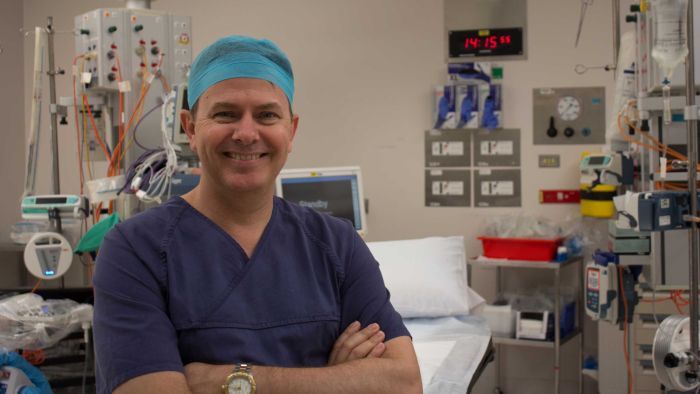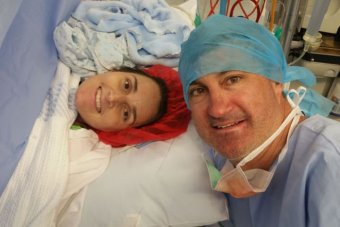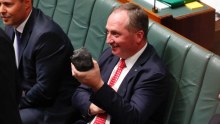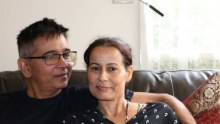Spina bifida surgery brings new hope to couple after triple diagnoses
Updated
Discontinuing two pregnancies due to diagnoses of spina bifida left Sydney couple Claudine and Dave Fitzgibbon in a dark place.
So when Claudine received a third diagnosis with her next pregnancy in 2016, she and her husband were devastated.
But this time their doctor held out a sliver of hope.
A team of surgeons at Brisbane's Mater Hospital had just performed pioneering in-utero surgery on a baby with spina bifida and they were looking for more patients.
It was not a cure for spina bifida, but it gave the Fitzgibbons confidence they were doing everything they could for a baby they were determined to keep no matter what.
Groundbreaking surgery
 Video: Dr Glenn Gardener's team performed the second-ever in-utero surgery in Australia to repair Harvey's spina bifida defect.
(ABC News)
Video: Dr Glenn Gardener's team performed the second-ever in-utero surgery in Australia to repair Harvey's spina bifida defect.
(ABC News)
Spina bifida is a congenital defect where the developing baby's spine fails to form normally. It occurs in about one in 2,000 pregnancies and can lead to problems with mobility, brain function and continence.
Until now, the options for women carrying a baby with spina bifida were to proceed with the pregnancy and deal with the disabilities associated with the condition or to terminate.
About 80 per cent of women choose the latter option, according to Claudine and Dave's obstetrician Dr Antonia Shand.
It is a devastating decision that must be made quickly, as the condition is often not diagnosed until the 20-week scan.
The option of in-utero surgery to repair the spinal defect has been available in the US since 1997, but it was only after a 2011 study confirmed its benefits that Australian doctors considered performing the surgery here.
In July last year, a team from Vanderbilt University Hospital in the US came to Australia to supervise and help perform the first operation in Brisbane.
During the delicate operation, the woman's abdomen and uterus were cut open to expose the foetus so surgeons could close the defect on the spine.
The advantage of operating on the foetus rather than the newborn child is that it reduces nerve damage and the likelihood of the child needing a shunt to regulate the flow of brain fluid.
Doctors have stressed the operation can be risky to both mother and child. It also significantly increases the chances of premature birth.
Claudine's procedure was headed by the Mater Hospital's Dr Glenn Gardener, who said while it was not a cure for spina bifida, it could increase the quality of life for the child.
Dozens of doctors are in the operating theatre during the delicate surgery.
"We mark out a site where we can safely get access [and] that exposes the baby's back. The neurosurgeon steps in and with the plastic surgeon they close the spina bifida defect on the baby's lower spine," Dr Gardener said.
'It was incredibly hard': A couple's journey
One of eight children, Claudine had always wanted a large family herself.
But after giving birth to a healthy girl, Eliza, she received the first of the spina bifida diagnoses 20 weeks into her next pregnancy.
 Photo:
The surgery increases the risk of premature birth. Harvey was delivered by caesarean at 33 weeks. (Supplied: Claudine Fitzgibbon)
Photo:
The surgery increases the risk of premature birth. Harvey was delivered by caesarean at 33 weeks. (Supplied: Claudine Fitzgibbon)
"I remember that first scan; it was like an emotional bomb just hit us," Dave told Australian Story.
The couple's strong Catholic faith made it difficult for them to even contemplate termination of baby Sophie, but the more they researched spina bifida the more concerned they became.
What is spina bifida?
- A birth defect where a baby's spinal cord fails to develop properly in the womb
- Occurs in about 1 in 2,000 pregnancies
- In severe cases, the spinal nerves protrude through a lesion in the baby's back
- It is thought to be caused by a combination of genetic and environmental factors
- The impact depends on the level of the spinal lesion but may involve problems with mobility, fluid build-up on the brain and continence. Some children require a shunt to regulate the amount of brain fluid
- In many cases spina bifida can be prevented by taking folate before and during pregnancy
- There is no cure
Ultimately they made the heartbreaking decision to discontinue the pregnancy.
"To choose not to have a baby, a wanted child, in your family because there's something wrong with her … I mean it's awful," Claudine said.
Dr Shand told Claudine the odds of having another baby with the condition were now slightly higher, but still slim and instructed her to take high doses of folate.
She fell pregnant quickly, but at 19 weeks discovered that baby Willow also had spina bifida.
"The second time around, it was incredibly hard on both of us," Claudine said.
"We just couldn't believe that the choice was in front of us again."
This baby's condition was even worse than the previous one, leaving Claudine and Dave little option but to discontinue the pregnancy.
Shattered but still desperate for another child, Claudine fell pregnant again.
The 12-week scan was fine, but at 16 weeks they received the devastating news — once again their baby had spina bifida.
"To deal with the decision once and then to deal with the decision twice and then to deal with the decision a third time — it was just an exhausting time," Dave said.
"It nearly broke me to lose Willow and I couldn't do it again," Claudine said.
'He is just a miracle'
The couple begged Dr Shand for another option and by a stroke of luck her former colleague, Dr Gardener, was about to take part in the first in-utero operation in Brisbane.
He was looking for a second patient and this time the surgery would be done without the help of the US experts.
Claudine met the narrow criteria for the operation, and within weeks she was in Brisbane preparing for surgery.
 Photo:
Claudine and Dave Fitzgibbon say they would have had Harvey regardless of whether surgery was an option. (Supplied: Mater Hospital)
Photo:
Claudine and Dave Fitzgibbon say they would have had Harvey regardless of whether surgery was an option. (Supplied: Mater Hospital)
The operation went well and she was told to take it easy to avoid a premature birth. However, at 33 weeks she started to experience discomfort and the doctors decided to deliver baby Harvey immediately.
Despite his early arrival, Harvey's doctors and his parents are delighted with his progress.
His kidneys and bladder are functioning well and his legs seem strong. He has slightly enlarged ventricles in the brain, which are monitored by monthly ultrasounds, but he does not require a shunt at this stage.
"We're not going to know some of the outcomes until year one, year two, even year three," Dave said.
"But we just feel very fortunate, very relieved and believe that we've had a great result.
For Claudine, Harvey's birth was a bittersweet moment.
"I couldn't help feeling when I touched Harvey's hand that it could have been one of our girls and I wondered how on Earth did I make that decision not to have them here with us," she said.
"But I can't torture myself with that."
She said that after the trauma of giving up two babies, they would have had Harvey no matter what, but the surgery made them feel they were giving him the best chance possible.
"We are so grateful to so many people," Claudine said.
"I look at him and I just think that he is a miracle."
 Photo:
Dave Fitzgibbon says Harvey's condition may not be fully determined for several years. (ABC News: Greg Hassall)
Photo:
Dave Fitzgibbon says Harvey's condition may not be fully determined for several years. (ABC News: Greg Hassall)
Watch Australian Story's "The Hardest Choice" tonight, 8pm on ABC TV and ABC iview.
Topics: medical-procedures, medical-research, doctors-and-medical-professionals, babies---newborns, people, brisbane-4000, sydney-2000
First posted








